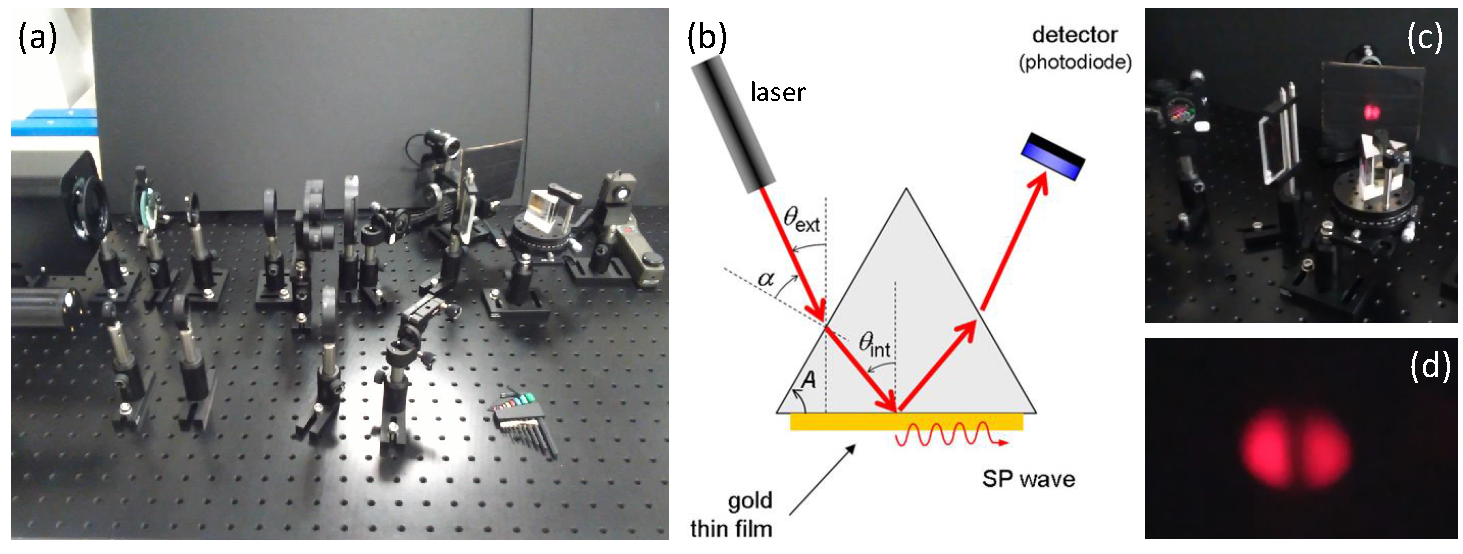Condensed Matter
I-Condensed Matter Physics
I.1 – Propagating surface plasmon
 Figure 1– (a) Experimental setup to observe the propagating surface plasmon. The glass prism (see (b), (c)) is used as a surface plasmon launcher and the propagating surface plasmon is observed at the gold-air interface, resulting in strong optical absorption at a given angle of incidence (see (c), (d)). The sketch in (b) is adapted from O. Pluchery et al., Eur. J. Phys 32, 585 (2011).
Figure 1– (a) Experimental setup to observe the propagating surface plasmon. The glass prism (see (b), (c)) is used as a surface plasmon launcher and the propagating surface plasmon is observed at the gold-air interface, resulting in strong optical absorption at a given angle of incidence (see (c), (d)). The sketch in (b) is adapted from O. Pluchery et al., Eur. J. Phys 32, 585 (2011).
The plasma oscillation is well-known in bulk metals and corresponds to a collective, resonant oscillation of conduction electrons. In this lab, we propose to generalize the observation of such phenomena in two dimensions, at the interface between a thin metal film (here gold) and a dielectric medium (here, ambient air). The resulting electromagnetic waves are called surface plasmons and propagate along the interface and are strongly confined in the transverse direction. The students will build an optical setup that enables the observation of the surface plasmon resonance and the measurement of its dispersion relation.
Keywords: Electrodynamics, nano-optics, metals, Drude model, light-matter interactions
1.2 – Acousto-optic diffraction
Acousto-optics (AO) uses the interaction between acoustic (sound) waves, of mechanical origin, and light waves. This phenomenon has first been described theoretically by Léon Brillouin in 1922 and observed in the 1930’s. AO diffraction can be described as follows: an acoustic wave, produced for example by a piezoelectric transducer, propagating in a solid or liquid medium, generates periodic stress in it (compression-expansion). The resulting strain field will generate a refractive index variation (photoelastic effect) with a spatial and temporal periodicity. The refractive index grating arising from acousto-optic interaction will then influence certain parameters of the light wave passing through the material (intensity, frequency, direction, …). In this lab, the students will quantitatively explore different AO diffraction regimes. Using a Bragg cell and a home built AO modulator. They will also exploit AO phenomena in order to transmit a message (for instance the output of a radio) through a laser beam.
Keywords: Optics, acoustics, diffraction, telecommunications
1.3 – Magneto-optical Kerr effect (MOKE)
This lab proposes an experimental introduction to the vast field of magnetism. Its purpose is to measure the magnetization cycles of magnetic thin films made of one or a few layers of magnetic materials using the magneto-optical Kerr effect (MOKE, named after the Physicist John Kerr). This technique exploits the change in the polarization state of an electromagnetic wave reflected by a magnetic material to yield an optical signal proportional to the magnetization along the direction of an externally applied magnetic field. The students will observe and decrypt magnetic hysteresis cycles by considering the competition between the magneto-crystalline anisotropy, the exchange interaction and the Zeeman effect. The students may also use a simulator of hysteresis cycles to further understand their results.
Keywords: Magnetism, magneto-optical effects, spintronics
1.4 – Current-voltage characteristics and magneto-resistance
This lab aims at exploring the relationship between the applied bias and the resulting electrical current flowing through an elementary circuit (a metallic thin film, a tunnel junction) and the applicability of Ohm’s law. Next, the students investigate non bi-univocal (here, hysteretic) current-voltage characteristics in an electroswitch or a tunnel diode. In a second part, the students are introduced to magneto-resistive effects, namely anisotropic magneto-resistance and giant magneto resistance in magnetic thin films using similar samples as in the MOKE lab. Here also a simulator of magneto-resistive cycles is available.
Keywords: Electron transport, Ohms law, hysteresis, magnetism, spintronics